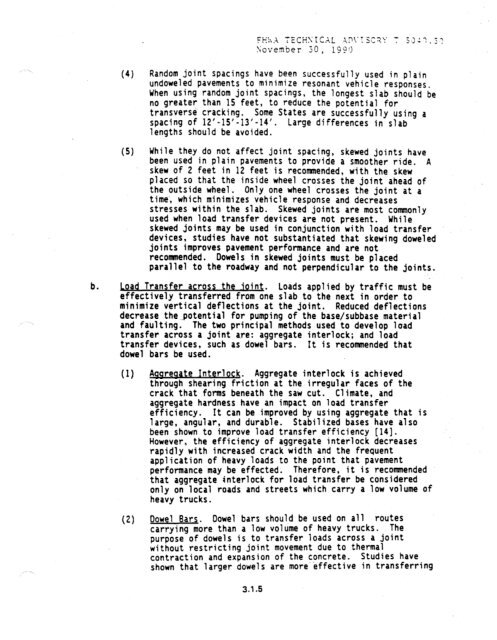chapter 3 rigid pavement - DOT On-Line Publications - Department ...
chapter 3 rigid pavement - DOT On-Line Publications - Department ...
chapter 3 rigid pavement - DOT On-Line Publications - Department ...
You also want an ePaper? Increase the reach of your titles
YUMPU automatically turns print PDFs into web optimized ePapers that Google loves.
November 30, 1990<br />
(4) Random joint spacings have been successfully used in plain<br />
undoweled <strong>pavement</strong>s to minimize resonant vehicle responses.<br />
When using random joint spacings, the longest slab should be<br />
no greater than 15 feet, to reduce the potential for<br />
transverse cracking. Some States are successfully using a<br />
spacing of 12'-15'-13'-14'. Large differences in slab<br />
lengths should be avoided.<br />
(5) While they do not affect joint spacing, skewed joints have<br />
been used in plain <strong>pavement</strong>s to provide a smoother ride. A<br />
skew of 2 feet in 12 feet is recommended, with the skew<br />
placed so that the inside wheel crosses the joint ahead of<br />
the outside wheel. <strong>On</strong>ly one wheel crosses the joint at a<br />
time', which minimizes vehicle response and decreases<br />
stresses within the slab. Skewed joints are most commonly<br />
used when load transfer devices are not present. While<br />
skewed joints may be used in conjunction with load transfer<br />
devices, studies have not substantiated that skewing doweled<br />
joints improves <strong>pavement</strong> performance and are not<br />
recommended. Dowels in skewed joints must be placed<br />
parallel to the roadway and not perpendicular to the joints.<br />
b. Load Transfer across the .ioint. Loads applied by traffic must be<br />
effectively transferred from one slab to the next in order to<br />
minimize vertical deflections at the joint. Reduced deflections<br />
decrease the..potential for pumping of the base/subbase material<br />
and faulting. The two principal methods used to develop laad<br />
transfer across a joint are: aggregate interlock; and load<br />
transfer devices, such as dowel bars. It is recommended that<br />
dowel bars be used.<br />
(1) Aaareaate Interlock Aggregate interlock is achieved<br />
through shearing friction at the irregular faces of the<br />
crack that forms beneath the saw cut. Climate, and<br />
aggregate hardness have an impact on load transfer<br />
efficiency. It can be improved by using aggregate that is<br />
large, angular, and durable. Stabilized bases have also<br />
been shown to improve load transfer efficiency [14].<br />
However, the efficiency of aggregate interlock decreases<br />
rapidly with increased crack width and the frequent<br />
application of heavy loads to the point that <strong>pavement</strong><br />
performance may be effected. Therefore, it is recommended<br />
that aggregate interlock for load transfer be considered<br />
only on local roads and streets which carry a low volume of<br />
heavy trucks.<br />
(2) Oowel Bars. Dowel bars should be used on al 1 routes<br />
carrying more than a low volume of heavy trucks. The<br />
purpose of dowels is to transfer loads across a joint<br />
without restricting joint movement due to thermal<br />
contraction and expansion of the concrete. Studies have<br />
shown that larger dowels are more‘effective in transferring<br />
3.1.5
















